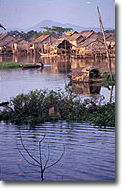The Tonle Sap

During the dry season (March - April), water
flows out from the Great Lake, the Tonle Sap, and joins the Mekong
on its way to the South China Sea. In the wet season (April -
September), so much water flows down the Mekong that it reverses
the flow of the Tonle Sap and the lake triples in size. This vast
floodplain may be the most productive inland fishery in the world.
Its well being is vital to the people of Cambodia and to the overall
health of the basin. In 1997, UNESCO declared the Tonle Sap Lake
and River System a World Biosphere Reserve.

The Mekong Delta
The Mekong Delta is one of the most densely populated areas on Earth. It is also one of the most productive. Often referred to as Viet Nam's 'rice bowl', the Delta produces upwards of 16 million tonnes of rice annually for domestic consumption and export in addition to highly productive shrimp farms, orchards and market gardens. Maintaining this productivity depends on understanding and, with the help of upstream neighbours, dealing with problems of sediment flow, soil salination and flooding. Every year, annual floods enrich the Delta soils and bring millions of fish to spawn. Sediments carried from far upstream replace the land lost through natural erosion. Without careful management upstream, flooding will become more frequent and more extreme, cancelling out these benefits and causing millions of dollars of damage and lost lives. In the dry season, there must be enough water flowing through the Delta to prevent the South China Sea from inundating thousands of hectares of farmland and ruining the soil with salt.
Deep Pools

At the height of the rainy season, the Mekong River Basin is like a vast fish pond teeming with aquatic plants and animals in fields and ponds, lakes, streams and even in roadside ditches. Come April and May, fields and ponds have dried up, streams have become trickles and the mainstream itself drops as much as 15 metres. Researchers have only recently discovered that a number of valuable fish species have for centuries retreated to deep stretches of the river to wait out the dry season. So far, 58 'deep pools' have been identified along one stretch of river alone (Kratie to Stung Treng in Cambodia). Very little is known yet about the special ecological characteristics of deep pools but it seems clear that deep pools provide important dry season refuges for valuable species and must be treated as integral elements of the overall ecosystem.
Read more about deep pools in MRC Technical Paper No. 4, April 2002, and MRC Technical Paper No. 11, 2006
Choose a newsletter:
 Top
Top